Adverse Events and Pharmacovigilance
Pharmacovigilance: the science and activities behind detecting, assessing, and preventing adverse effects of veterinary medicines
Safety & Efficacy Surveillance
animals, people, and the environment
What is pharmacovigilance?
The World Health Organization has defined pharmacovigilance as the science and activities relating to the detection, assessment, understanding and prevention of adverse effects or any other medicine-related problem.
Adverse effects, also known as adverse events, may be undesirable side effects, such as adverse reactions, or a medicine may not work as expected, known as a lack of expected efficacy. The effects may be seen, for example, in the animal being treated, in other animals, the person handling the medicine or in the environment.
Who should report adverse events?
Anyone can report a reaction to a veterinary medicine that affects a person, animal or the environment. You can also report if an animal medicine has not worked.
It is particularly important for vets to report events and provide as much clinical detail as possible. We will use the information you provide to help improve the safe and effective use by, in some cases, adding additional warnings to the labels.
How to report?
There are several ways to report:
- to your vet or retailer: Its a good idea to let your vet know if your animal has experienced a reaction.
- to the Marketing Authorisation Holder (MAH): Contact details are always given on the product packaging and leaflet. MAHs must collate this information and provide the VMD with regular safety updates which includes all reports.
- to the VMD: Anyone can report adverse event directly to us, even if you have already reported it elsewhere. The MA holder will pass this on though so no need to report twice.

Needlestick injuries
These types of injuries can be severe and have life-long consequences. Thankfully, occurrences are rare compared to the many millions of injectable doses administered every year.
List of Services
-
Amputation of digitsItem Link List Item 1
Although rare, we have known this to occur from extreme tissue irritation and necrosis due to exposure to mineral oil vaccines
-
Swelling and painItem Link List Item 2
This is the most common side effect, particularly through infection from dirty needles or live viral or bacterial vaccines
-
Permanent reduced mobilityItem Link List Item 3
Reduced mobility and long-term pain has permanently prevented some people from working
Mineral oil is used as an adjuvant in some vaccines
Adjuvants are added to increase the ability of the antigen to stimulate the body's immune response. These are listed in the product's Summary of Product Characteristics with the ingredients. SPCs for all authorised products are on our Product Information Database.
Mineral oil can cause significant harm at self-injection sites due to its irritant nature. If you accidently self-inject take it seriously and act quickly.
Precautions that should be taken
- ensure animals are properly restrained and take your time
- be alert to unexpected movements
- be aware of the risks associated with the product
- know what it contains, such as mineral oil
- use clean, well maintained equipment
- wear needle-proof gloves where possible
- use a vaccinator which includes a needle guard
- don't put uncovered needles in your pocket or in bags
- don't re-sheath needles, instead dispose of them appropriately
Actions you should take in the event of a needlestick injury
- assume the needle has penetrated the skin even if there is no initial reaction
- read the product information leaflet. These can also be found on our Product Information Database
- seek immediate medical attention, preferably at a hospital, and show them the product information leaflet
- warn medical staff the further signs can be expected
- if an oil-based vaccine was used, emphasise the need for immediate surgical cleaning
- as soon as you are able, report the incident to the VMD
Be prepared and be careful
Always seek medical attention
Tell the VMD or the Marketing Authorisation Holder
Definitions used in pharmacovigilance
List of Services
-
Adverse eventItem Link List Item 1
Any observation in animals, whether or not considered to be product-related, that is unfavourable and unintended and that occurs after any use of a veterinary medicine (off-label and on-label uses). Included are events related to a suspected lack of expected efficacy or noxious reactions in humans after being exposed to a veterinary medicine.
-
Adverse reactionItem Link List Item 2
A reaction to a veterinary medicine which is harmful and unintended and which occurs at doses normally used in animals for the prophylaxis, diagnosis or treatment of disease or to restore, correct or modify a physiological function.
-
Off-label useItem Link List Item 3
For authorised products, the Summary of Product Characteristics (SPC) describes what a product is indicated for, how a product should be used, and what adverse events may occur following treatment with a product. If the product has not been used according to the SPC, including the misuse and serious abuse of the product, this is off-label use.
-
Lack of expected efficacyItem Link List Item 4
The apparent inability of an authorised product to have the expected efficacy in an animal, according to the claims of the SPC and following use of the product in accordance with the SPC.
-
Unexpected adverse eventsItem Link
If the nature, severity or outcome of an observed adverse event is not described in the SPC, that event is unexpected.

